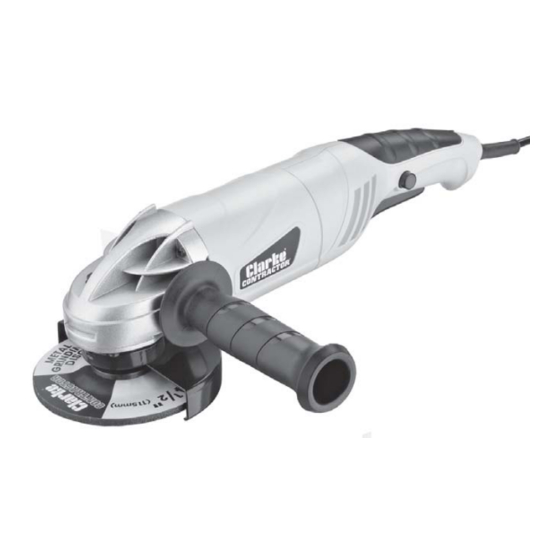
Summary of Contents for Clarke Contractor CON1050
- Page 1 1050W ANGLE GRINDER Model No. CON1050 PART NO: 6470142 OPERATING & MAINTENANCE INSTRUCTIONS GC0611...
-
Page 2: Introduction
INTRODUCTION Thank you for purchasing this CLARKE Angle Grinder. Before attempting to use the machine, please read this manual thoroughly and follow the instructions carefully. In doing so you will ensure the safety of yourself and that of others around you, and you can look forward to your purchase giving you long and satisfactory service. -
Page 3: Table Of Contents
TABLE OF CONTENTS INTRODUCTION .................. 2 GUARANTEE ..................2 ENVIRONMENTAL PROTECTION ............2 TABLE OF CONTENTS ................3 GENERAL SAFETY RULES ..............4 ANGLE GRINDER SAFETY INSTRUCTIONS ........... 6 DISC SAFETY INSTRUCTIONS .............. 7 ELECTRICAL CONNECTIONS .............. 8 OVERVIEW ..................9 BEFORE USE .................. -
Page 4: General Safety Rules
GENERAL SAFETY RULES WORK AREA 1. Keep the work area clean and well lit. Cluttered and dark areas invite accidents. 2. Do not operate power tools in explosive atmospheres such as in the presence of flammable liquids, gasses or dust. Power tools create sparks which may ignite dust or fumes. - Page 5 5. Dress properly. Do not wear loose clothing or jewellery which may get caught in moving parts. Wear protective hair covering to contain long hair. For best footing, wear rubber soled footwear. Keep floor clear of oil, scrap wood, etc. 6.
-
Page 6: Angle Grinder Safety Instructions
ANGLE GRINDER SAFETY INSTRUCTIONS 1. Before starting work, always consider that the use of hand held angle grinders for grinding and cutting operations can present risks to the user. Full observation of the safety instructions in this user guide is essential. Always use the correct tool for the job. -
Page 7: Disc Safety Instructions
16. Do not allow bystanders (children or adults) to be nearby when using an angle grinder. 17. Ensure that sparks and particles resulting from grinding do not create a hazard. Use screens where appropriate. 18. Do not use the angle grinder without the disc guard. Make sure that the guard is securely fitted before operating the angle grinder. -
Page 8: Electrical Connections
ELECTRICAL CONNECTIONS WARNING! Read these electrical safety instructions thoroughly before connecting the product to the mains supply. Before switching the product on, make sure that the voltage of your electricity supply is the same as that indicated on the rating plate. This product is designed to operate on 230VAC 50Hz. -
Page 9: Overview
OVERVIEW When unpacking, check for damage or shortages etc. Any found should be reported to your CLARKE dealer where the appliance was originally purchased. This CON1050 is supplied with the following components: • 1 x Disc Guard • 1 x Grinding Disc 1 x Pin Spanner •... -
Page 10: Before Use
BEFORE USE FITTING / ADJUSTING THE DISC GUARD WARNING: ENSURE THAT THE GRINDER IS SWITCHED OFF AND UNPLUGGED FROM THE MAINS SUPPLY BEFORE FITTING OR REMOVING THE DISC. 1. Slide the disc guard over the end of the grinder as shown. 2. -
Page 11: Operation
6. Press and hold the spindle lock and use the pin spanner to tighten the outer flange. Care should be taken also NOT to overtighten the outer flange. FITTING THE SIDE HANDLE 1. Fit the side handle by screwing it into the threaded hole on either left or right hand side of the angle grinder. -
Page 12: Maintenance
CUTTING TIPS • Do not force the disc through the material. Work with a feed rate that is suited to the material being cut. • Do not subject the cutting disc to sideways pressure. • The direction of the cutting motion is important. Always feed the cutting disc into the work so that it cuts in an upward direction. -
Page 13: Fault Finding
• All bearings etc, in this tool are lubricated with a sufficient amount of high grade lubricant for the tools lifetime under normal operating conditions, therefore no further lubrication is necessary. • Refer to your CLARKE dealer if internal maintenance is required. FAULT FINDING l l i . -
Page 14: Consumable Spare Parts
& Please note that the details and specifications contained herein, are correct at the time of going to print. However, CLARKE International reserve the right to change specifications at any time without prior notice. Parts & Service: 020 8988 7400/E-mail:Parts@clarkeinternational.com or Service@clarkeinternational.com... -
Page 15: Parts Diagram & List
PARTS DIAGRAM Parts & Service: 020 8988 7400/E-mail:Parts@clarkeinternational.com or Service@clarkeinternational.com... -
Page 16: Parts List
PARTS LIST v i r v i r Parts & Service: 020 8988 7400/E-mail:Parts@clarkeinternational.com or Service@clarkeinternational.com... -
Page 17: Vibration Emissions
‘K’, which represents the uncertainty factor, i.e. a value in excess of ‘a’, to which the tool could vibrate under normal conditions. These values appear in the specification panel below. MODEL No: CON1050 DESCRIPTION: 1050W ANGLE GRINDER Declared vibration emission value in accordance with EN12096 Measured vibration emission value - a: 24.44m/s... - Page 18 You will note that a third value is given in the specification - the highest measured reading in a single plane. This is the maximum level of vibration measured during testing in one of the axes, and this should also be taken into account when making a risk assessment.
-
Page 19: Declaration Of Conformity
DECLARATION OF CONFORMITY Parts & Service: 020 8988 7400/E-mail:Parts@clarkeinternational.com or Service@clarkeinternational.com...

















Need help?
Do you have a question about the Contractor CON1050 and is the answer not in the manual?
Questions and answers